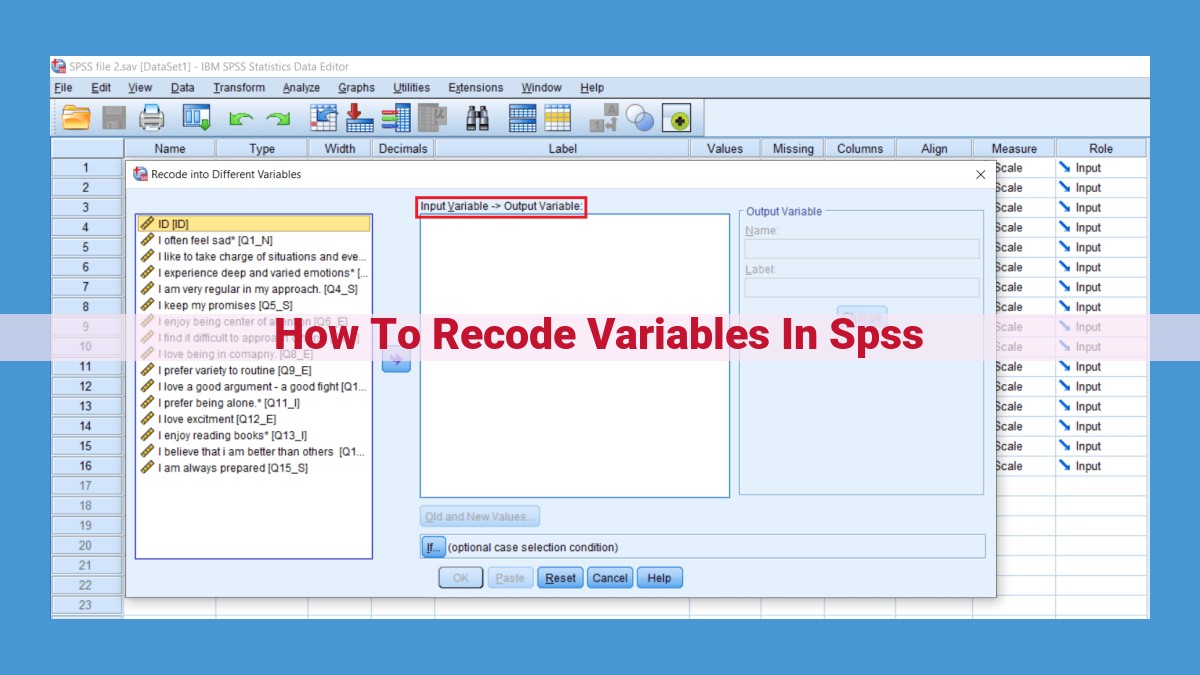Recoding involves transforming existing variables to create more meaningful or useful ones. Methods include modifying values within the same variable (Old and New Values, Values, Copy old values, Do not copy old values) or creating a new variable with recoded values. Additionally, you can specify a range of values to recode and choose new values to be numerical, categorical, or missing. Consider copying old values based on research needs, or delete old values to simplify the dataset.
What is Recoding Variables?
- Define recoding as the process of transforming existing variables.
- Explain its purpose to create more meaningful or useful variables.
What is Recoding Variables: A Guide to Transforming Data for Meaningful Insights
In the realm of data analysis, recoding variables is a powerful technique that allows us to transform existing variables into more meaningful and useful ones. It’s like giving data a makeover, reshaping it to better fit our analytical needs.
Why Recode Variables?
When we collect data, it often comes in a raw form that may not always be suitable for our analysis. Some variables might have inconsistencies, redundancies, or categories that don’t align with our research questions. Recoding enables us to address these issues, creating variables that are tailored to our specific needs.
Recoding Methods: Breathing New Life into Data
There are two main ways to recode variables:
- Recode into the Same Variable: This method allows us to modify the values within an existing variable. We can replace old values with new ones, remap values, or even copy old values to a new variable.
- Recode into a New Variable: With this method, we create a completely new variable with recoded values. The options for creating a new variable are similar to those for recoding into the same variable, giving us great flexibility in tailoring the new variable to our needs.
Recoding Methods: Transforming Variables for Enhanced Analysis
In the realm of data analysis, effectively utilizing the available information is crucial for extracting valuable insights. Recoding variables is a powerful technique that enables researchers and analysts to modify existing variables to create more meaningful and useful data points tailored to their specific research questions.
Recoding into the Same Variable
When the goal is to modify values within an existing variable, recoding into the same variable offers several options. The Old and New Values option allows for precise modifications by specifying the exact values that need to be changed, along with their corresponding new values. Alternatively, the Values option allows for modifying a range of values simultaneously, providing efficiency for large datasets.
In both cases, you have the choice of copying old values into the new variable or not copying old values. Copying old values ensures that the original data remains intact while incorporating the new modifications. However, not copying old values can potentially simplify the dataset by removing redundant information.
Recoding into a New Variable
To create a completely new variable with recoded values, you can utilize the Recode into New Variable method. This option mirrors the options available for recoding into the same variable, with the added advantage of generating a fresh variable that captures only the modified values.
The choice between recoding into the same variable or a new variable depends on the specific research question and the desired analysis outcomes. If the modifications are intended to supplement the existing data without altering its overall structure, recoding into the same variable is suitable. However, if the new variable is meant to serve a distinct purpose or simplify the dataset, recoding into a new variable is the optimal choice.
Additional Considerations
When performing recoding, several additional considerations require attention. Specifying a range of values allows for modifying a group of consecutive values simultaneously. The values that are created can be numerical, categorical, or missing. Depending on the research context, you may need to determine whether to copy old values or not copy old values into the new variable, considering factors such as preserving original data or streamlining the dataset.
Recoding Variables: Essential Guide for Meaningful Data Manipulation
Understanding Recoding
Recoding is an invaluable data transformation technique that allows you to modify existing variables to create more insightful and useful insights. By altering the values or structure of variables, you can simplify your analysis, enhance data readability, and unearth hidden patterns.
Recoding Methods
There are two primary methods of recoding variables:
A. Recoding into the Same Variable
This approach alters the values within the original variable. Options include:
- Old and New Values: Replace specific old values with new ones.
- Values: Reassign values based on a set of rules (e.g., above a threshold).
- Copy old values: Retain the original values in the variable.
- Do not copy old values: Eliminate the original values in the variable.
B. Recoding into a New Variable
This method creates a new variable with the recoded values. The options are similar to those in “Recoding into the Same Variable.”
Additional Considerations
When recoding variables, several crucial factors need to be taken into account to ensure the validity and utility of your results:
A. Range
You can specify a range of values to be recoded. This allows you to target specific data points for modification.
B. Values
New values can be numerical, categorical, or missing. Choose the value type that best aligns with your research question and analysis needs.
C. Copying Old Values
Carefully consider whether to copy old values into the new variable. This decision should be guided by the research question and the specific needs of your analysis.
D. Do Not Copy Old Values
Deleting original values when creating a new variable can simplify your dataset by removing redundant information. However, ensure that the resulting dataset still provides the necessary data for your analysis.
